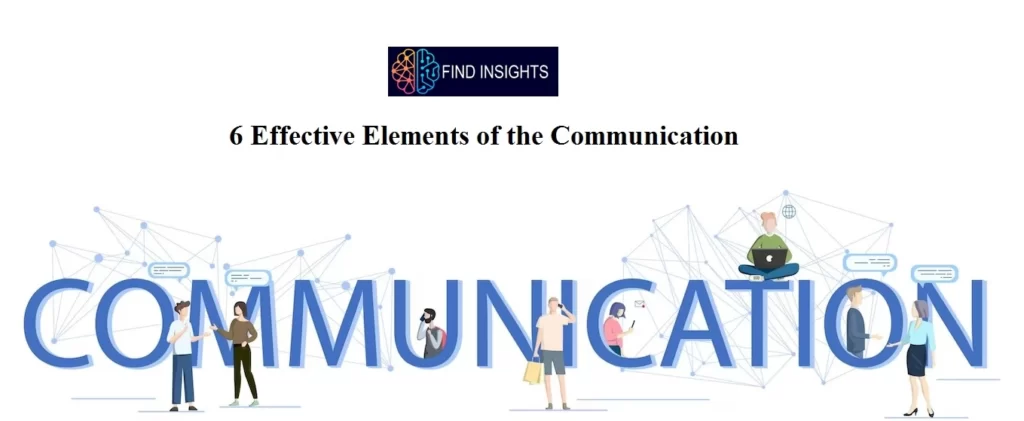
Introduction: Elements of the Communication
Even the use of the most sophisticated technology cannot guarantee effective communication. The world is changing rather fast and the communicator has to keep pace with the change. In this article lets see 6 effective elements of the communication.
Basic elements of the communication
Basic elements of the communication process are as follows:
1) The sender or the communicator
2) The message
3) Encoding
4) The medium / channel
5) The receiver
6) Decoding
7) Feedback
6 Effective Elements of the communication
Clarity of Thought and Expression:
- The communicator must first know what he/she wants to convey and why. It is very much essential that he/she understands the purpose of his message.
- Communication without a clear objective amounts to groping in darkness like the seven blind men arguing the size of the elephant. The message should be clear in order to solicit effective feedback.
- Effective communication begins when someone thinks clearly. You should know what you want to communicate. And the better you know it, the more clearly you can communicate it. Clarity of thought and expression is central to effective communication.
- If you cannot think clearly; you cannot express yourself clearly. Never think communication is spontaneous; you have to make it happen. The major mistake in communication is to believe that is happens.
Correctness / Appropriateness:
- The message should not only be candid and also be clear, it should also be correct. It should be correct in spelling, grammar, content and format.
- Be sure that the statistical data, if you are using any, is correct. Use specific facts and figures. Ensure that the rules and conventions of spelling, grammar, punctuation, usage, and also idiom are correctly used as also style (appropriateness of word choice and level of formality to audience, purpose, and material).
- Rules of grammar and syntax (and punctuation) are to be followed to avoid ambiguity. Check if social and cultural appropriateness have been maintained. Make sure that the timing and choice of medium are appropriate to the purpose, audience, and also material.
Conciseness:
- The message should be concise: it should give only the information that is necessary and important, using as few words as possible but not sacrificing its completeness and clarity. Concise messages save time, catch attention by their terseness and reduce noise.
- First ensure that the material is arranged in a logical and coherent sequence and examples are relevant, specific, detailed, sufficient and persuasive. In most of the communications, particularly business communication, it is always advisable to come straight to the point.
Conducive Environment:
- The environment in which a message is sent or received can also affect its meaning, shows a research. “News stories on a general-interest news website might never appear in a newspaper circulated in the financial community.
- What’s important to readers in times of war differs from what’s important in times of natural disaster when traditional media might not even be operating.
- Communicators must understand the environment in which they are sending messages to help their audience received information in the context in which was intended,” argues an expert.
Feedback:
- Communication is a two-way street: it needs the efforts of both the sender and the receiver for success. It is a complex process. The communication, in spite of all efforts, may fail simply because the receiver somehow fails to provide feedback or the sender fails to interpret the feedback correctly. Then, do you think communication is difficult? If your answer is ‘yes’ you’re right. “Communication is so difficult,” asserts a guide, because at each step in the process there is major potential of error. By the time a message gets from a sender to a receiver, there are four basic places where transmission errors can take place and at each place, there are a multitude of potential sources of error. Thus, it is no surprise that social psychologists estimate that there is usually a 40-60% loss of meaning in the transmission of messages from sender to receiver.
- It is critical to understand this process, understand and be aware of the potential sources of errors and constantly counteract these tendencies by making a conscientious effort to make sure there is a minimal loss of meaning in your conversation. It is also very important to understand that a majority of communication is non-verbal.” Inability to follow feedback properly might spoil the very purpose of communication. In order to be able to study feedbacks and responses, many factors including the language and culture of the receiver/audience are to be judged. That is why you need to be familiar with your audience; however, it may not be possible always. But you can recognize their feelings and anticipate reactions. The receiver also partly bears the onus of making the communication successful through effective feedback.
- Completeness:
- Communication intends to create meaning and understanding and therefore needs to be complete in all respects. Incomplete message breeds misunderstanding and faulty interpretation. Even sometimes a communicator, in his/her eagerness to become concise, adopts shortcuts.
- Clarity is hampered in absence of completeness. To highlight the point, a group of communication specialists observes: “Completeness offers numerous benefits. First, competes message is more likely to bring the desired results without the expense of additional messages. Second, they can do a better job of building goodwill.
- Messages that contain information the receiver needs show concern for others. Third, complete messages can help avert costly lawsuits that may result if important information is missing. Last, communications that seem inconsequential can be surprisingly important if the information they contain is complete and effective.” So provide all necessary and relevant information to your receiver.
Benefits of Elements of the Communication

The elements of the communication are regarded as important and there are number of benefits. Communication takes place between two or more individuals, which are senders, who are imparting information and also the receivers, who are receiving information. The elements of the communication also imparts understanding among the individuals that they need to adequately take into account the aspects of, verbal messages, non-verbal messages, clarity of thought and also expression, precision and appropriateness, conciseness, conducive environment, channel, feedback, completeness and also context. The benefits of elements of the communication are stated as follows:
- Understanding Viewpoints and Perspectives
- Bringing about Improvements
- Generating Awareness.
- Generating the Desired Outcomes
- Promoting Effective Terms and also Relationships with Others
- Promoting Co-ordination and Integration
- Making Effective Decisions
- Increase Managerial Efficiency
- Establish Efficient Leadership .
- Increase Motivation and also Employee Morale
LIKE WHAT YOU’RE READING?
CHECK OUT SOME OF OUR OTHER GREAT CONTENT HERE
- THE ART OF PUBLIC SPEAKING (STEP BY STEP GUIDE)
- HOW TO IMPROVE COMMUNICATION SKILLS?
- PROFESSIONAL & BUSINESS COMMUNICATION
- WHAT IS A WRITTEN COMMUNICATION
- 7 NON VERBAL MEANS OF COMMUNICATION
- TOP SKILLS EVERY ENTREPRENEUR SHOULD HAVE
- WHAT IS A WRITTEN COMMUNICATION
- LEARN PROBLEM SOLVING SKILLS
- LEARN THE ART OF LEADERSHIP SKILLS
- LEARN THE ART OF NEGOTIATION
- 7 EFFECTIVE PRINCIPLES OF COMMUNICATION
- 12 BEST TIPS TO OVERCOME BARRIERS FOR EFFECTIVE COMMUNICATION
- 5 BEST ENGLISH BOOKS FOR GRAMMAR




9 Comments